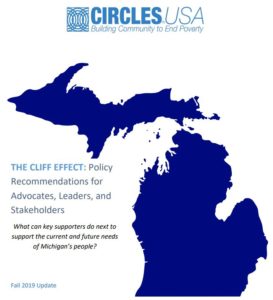
This report integrates research by Circles USA concerning the Cliff Effect, data from Michigan households utilizing public support, and three hypothetical family cases to develop both general and program-specific policy recommendations. These policy recommendations aim to mitigate the impact of the Cliff Effect on families receiving public assistance as they transition to economic self-sufficiency. The report focuses on the Cliff Effect from Michigan’s Family Independence Program (FIP), Food Assistance Program (FAP), and Child Development and Care Program (CDC). Policy-level recommendations focus on bringing awareness to key stakeholders (public officials, community leaders, and Michigan employers) about the impact of the Cliff Effect on families seeking economic self-sufficiency, development of community assistance programs to help families avoid cliffs, and the development of employment training programs to help displaced workers in Michigan.
Based on the most recent Census reports, the poverty rate in Michigan is 16.3%. The majority of those affected are single-parent (typically female-headed) households with one or more children.37 An estimated 23% of Michigan’s children current live in poverty, defined as less than 100% of FPLs.36 These numbers do not include an additional 25% of Michigan households who are considered “Asset Limited, Income Constrained, Employed (ALICE).” As a result, the Cliff Effect experienced by families moving off CDC benefits may be the highest priority for Michigan policy makers to address. Specific recommendations for Michigan’s CDC program include:
1. Extension of the program, at some level of benefit, to families with household incomes between 130% and at least 250% of FPLs.
2. Development of a graduated exit ramp, where the decrease in received subsidy is proportional to the amount the family’s earned income exceeds the exit criteria.
3. Development of CDC reimbursement rates categories that reflect the market rates for highly-rated daycare providers, reducing balance billing payments (the financial remainder which is passed on to parents) for families who are seeking quality care for their children.
